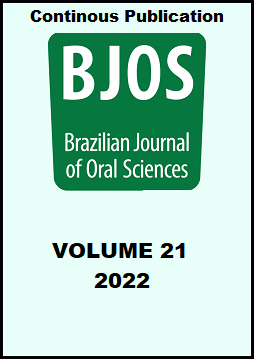Abstract
Aim: Although bulk fill composites have been widely used as restorative material, there is no consensus regarding the best clinical protocol in terms of composite technique and adhesive system. Therefore, this clinical trial evaluated the clinical performance of bulk fill composites for class I restorations under different protocols. Methods: A randomized clinical trial including 155 class I restorations was conducted using different adhesive systems: conventional technique (phosphoric acid + conventional three-step adhesive system) (Group 1, 2 and 3); or self-etching adhesive system (Groups 4, 5 and 6). Control groups 1 and 4 were restored with conventional composite; groups 2 and 5 with low viscosity bulk fill and conventional composite as occlusal coverage; groups 3 and 6 with high viscosity bulk fill. The FDI criteria was used for clinical evaluation at baseline and after 6 months. Results: All groups showed good clinical performance. At baseline, the adhesive system did not affect postoperative hypersensitivity. After 6 months, group 5 showed a significant reduction in color and translucency; group 6 a reduction in terms of anatomical form and for postoperative sensitivity and an improvement in patient satisfaction (p<0.05). Considering the same restorative technique, the use of the self-etching adhesive system showed a significant decrease in color and translucency (p<0.05). Conclusion: All groups showed favorable clinical performance, and promising results were found for the conventional adhesive system and high viscosity bulk fill protocol.
References
Ayar MK, Guven ME, Burduroglu HD, Erdemir F. Repair of aged bulk-fill composite with posterior composite: Effect of different surface treatments. J Esthet Restor Dent. 2019 May;31(3):246-52. doi: 10.1111/jerd.12391.
Klapdohr S, Moszner N. New inorganic components for dental filling composites. Monatshefte Chem. 2005;136:21-45.
Ferracane JL. Resin composite - state of the art. 2011 Jan;27(1):29-38. doi: 10.1016/j.dental.2010.10.020.
Fahim SE, Mostafa MA, Abi-Elhassan MH, Taher HM. Clinical behaviour and marginal sealing of Bulk-Fill resin composite restorations using light amplified high-intensity LEDs curing: a randomized controlled clinical trial. Open Access Maced J Med Sci. 2019 Apr 29;7(8):1360-8. doi: 10.3889/oamjms.2019.216.
Ayar MK. Postoperative sensitivity after placement of bulk-fill posterior restoration. J Res Med Dent Sci. 2017;5(3):53-8.
Silva FJV, Silva EL, Januário MVS, Vasconcelos MG, Vasconcelos RG. [Techniques for reducing the effects of polymerization shrinkage of composites photoactivated resins]. Salusvita. 2017;36(1):187-203. Portuguese.
Braga RR, Ballester RY, Ferracane JL. Factors involved in the development of polymerization shrinkage stress in resin-composites: a systematic review. Dent Mater. 2005 Oct;21(10):962-70. doi: 10.1016/j.dental.2005.04.018.
Bicalho AA, Tantbirojn D, Versluis A, Soares CJ. Effect of occlusal loading and mechanical properties of resin composite on stress generated in posterior restorations. Am J Dent. 2014 Jun;27(3):129-33.
Jain L, Mehta D, Meena N, Gupta R. Influence of light energy density, composite type, composite thickness, and postcuring phase on degree of conversion of bulk-fill composites. Contemp Clin Dent. 2018 Jun;9(Suppl 1):S147-52. doi: 10.4103/ccd.ccd_169_18.
van Dijken JWV, Pallesen U. Bulk-filled posterior resin restorations based on stress-decreasing resin technology: a randomized, controlled 6-year evaluation. Eur J Oral Sci. 2017 Aug;125(4):303-9. doi: 10.1111/eos.12351.
Pfeifer CS. Polymer-based direct filling materials. Dent Clin North Am. 2017 Oct;61(4):733-50. doi: 10.1016/j.cden.2017.06.002.
Ilie N, Stark K. Effect of different curing protocols on the mechanical properties of low-viscosity bulk-fill composites. Clin Oral Investig. 2015 Mar;19(2):271-9. doi: 10.1007/s00784-014-1262-x.
van Dijken JWV, Pallesen U. Posterior bulk-filled resin composite restorations: A 5-year randomized controlled clinical study. J Dent. 2016 Aug;51:29-35. doi: 10.1016/j.jdent.2016.05.008.
Heck K, Manhart J, Hickel R, Diegritz C. Clinical evaluation of the bulk fill composite QuiXfil in molar class I and II cavities: 10-year results of a RCT. Dent Mater. 2018 Jun;34(6):e138-47. doi: 10.1016/j.dental.2018.03.023.
Balkaya H, Arslan S, Pala K. A randomized, prospective clinical study evaluating effectiveness of a bulk-fill composite resin, a conventional composite resin and a reinforced glass ionomer in Class II cavities: one-year results. J Appl Oral Sci. 2019 Oct 7;27:e20180678. doi: 10.1590/1678-7757-2018-0678.
Costa T, Rezende M, Sakamoto A, Bittencourt B, Dalzochio P, Loguercio AD, et al. Influence of adhesive type and placement technique on postoperative sensitivity in posterior composite restorations. Oper Dent. 2017 Mar/Apr;42(2):143-54. doi: 10.2341/16-010-C.
Guney T, Yazici AR. 24-month clinical evaluation of different bulk-fill restorative resins in Class II restorations. Oper Dent. 2020;45(2):123-33. doi: 10.2341/18-144-C.
Loguercio AD, Rezende M, Gutierrez MF, Costa TF, Armas-Vega A, Reis A. Randomized 36-month follow-up of posterior bulk-filled resin composite restorations. J Dent. 2019 Jun;85:93-102. doi: 10.1016/j.jdent.2019.05.018.
Marques IP, de Oliveira FBS, Souza JGS, Ferreira RC, Magalhães CS, França FMG, et al. Influence of surface treatment on the performance of silorane-based composite resin in class I restorations: a randomized clinical trial. Clin Oral Investig. 2018 Dec;22(9):2989-96. doi: 10.1007/s00784-018-2390-5.
Hickel R, Roulet JF, Bayne S, Heintze SD, Mjör IA, Peters M, et al. Recommendations for conducting controlled clinical studies of dental restorative materials. Clin Oral Investig. 2007 Mar;11(1):5-33. doi: 10.1007/s00784-006-0095-7.
Benetti AR, Havndrup-Pedersen C, Honoré D, Pedersen MK, Pallesen U. Bulk-fill resin composites: polymerization contraction, depth of cure, and gap formation. Oper Dent. 2015 Mar-Apr;40(2):190-200. doi: 10.2341/13-324-L.
Ritter DD, Rocha RO, Soares FZ, Lenzi TL. Do adhesive systems influence the color match of resin composites? J Appl Biomater Funct Mater. 2016 May 18;14(2):e212-6. doi: 10.5301/jabfm.5000277.
Canali GD, Ignácio SA, Rached RN, Souza EM. One-year clinical evaluation of bulk-fill flowable vs. regular nanofilled composite in non-carious cervical lesions. Clin Oral Investig. 2019 Feb;23(2):889-97. doi: 10.1007/s00784-018-2509-8.
Colak H, Tokay U, Uzgur R, Hamidi MM, Ercan E. A prospective, randomized, double-blind clinical trial of one nano-hybrid and one high-viscosity bulk-fill composite restorative systems in class II cavities: 12 months results. Niger J Clin Pract. 2017 Jul;20(7):822-31. doi: 10.4103/1119-3077.212449.

This work is licensed under a Creative Commons Attribution 4.0 International License.
Copyright (c) 2021 Brazilian Journal of Oral Sciences


